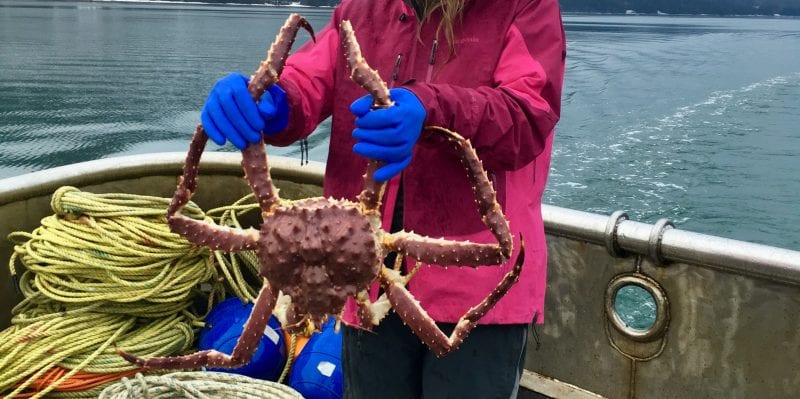One area of the fishery is still open in Southern Southeast but most of the region has closed to commercial red king crab fishing.
Data will remain estimates until mid-December as fish tickets are still being processed, but it appears that harvests fell short of what managers were targeting.
Using information from call-ins from fishermen and estimated weights managers estimate that just over 130,000 pounds of red king crab was caught. The guideline harvest or GHL that managers were shooting for was 201,200 pounds region wide.
But in this fragile fishery it’s better to stay under the guideline harvest levels than to go over it, according to state managers.
Joe Stratman is Alaska Department of Fish and Game’s lead crab biologist for Southeast.
“You kind of do the best you can with this,” Stratman said. “We knew management accuracy would be difficult. But we wanted to not exceed GHLs. We haven’t had a commercial fishery in a number of years. We wanted to get as close as we could to these and not exceed them and I think we did that.”
Managers approached the fishery conservatively because there were a lot of unknowns. They were trying to find a way to monitor harvests as they were happening. So they opened the fishery for just 24 hours and then conducted dock sampling for four days before re-opening two of the areas.
Managers weren’t sure how the effort was going to be distributed. Stratman says the stand down period for four days was vital.
“Without a stand down period it would have been difficult if not completely impossible to get any port sampling data and that’s really the only source of information we have on recruit percentage in the commercial harvest so we feel that’s important information,” he said.
Recruit crab are just reaching commercial harvestable size.
The 24 hour period included four surveyed areas. Some fishermen KFSK interviewed before the fishery thought it was too restrictive.
But harvests near Juneau were productive. In 11-A, Fish and Game estimates that 101 percent of the 18,600 pound GHL was taken.
In another area on Southern Admiralty Island, they estimate that approximately 57 percent of the 20,000 pound GHL harvest was taken.
Seymour Canal on Eastern Admiralty Island also had a 20,000 pound GHL and fishermen harvested about 29 percent of that.
Only one permit holder fished in Excursion Inlet so that information remains anonymous.
The Northern non-surveyed area closed on November 27 because managers estimated that they would reach the desired harvest level for the area. They think that 98 percent of harvest was taken there.
Information for the Southern Non-Surveyed area is not in yet. The area has a 35,000 pound GHL but Stratman says there are only a few fishermen there and there hasn’t been a big harvest.
All in all, the Juneau area appears to have met its harvest target while the other areas fell short. But the harvests mirror what managers have seen in recent surveys.
“I guess you always strive for management accuracy, as a manager, so ideally you’d get 100 percent of all six of these GHLs,” Stratman said. “But there is definitely a region wide component to this.”
What happens with the red king crab fishery in the future is unknown. But Stratman says the outlook is good.
“Just talking to the permit holders, I think people are encouraged with the red king crab, they seem to be seeing a lot of smaller crab,” Stratman said. “In some areas actually they were seeing some soft crab which was kind of interesting, light crab that they weren’t able to retain. We think that the molt is April, May, June so some areas may have had a late molt. Or, another thing that could happen is if there’s a lot of crab recruiting in a given year they could be competing for resources and that could mean it takes them longer to harden up and be marketable. So, I think there are some encouraging signs both what we’ve been seeing in our survey over the last few years and also in the fishery this year.”
Not all the tickets for the red king crab fishery have been processed but it looks like the average price was $10.35 a pound. That puts the total value of the fishery to date at $1.3 million.
Surveys for the king crab fishery next year begin in June.
The next commercial crab fishery in Southeast is for Tanner crab in February. The golden king crab fishery runs at the same time.










